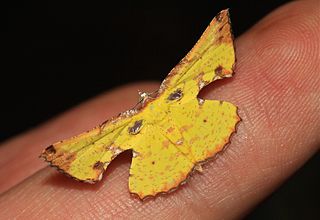
Loxa is an insect genus in the large family of shield bugs. It occurs primarily in Central America and Mexico, but is also found in Texas, Florida and South America. While Loxa is a genus of the tribe Pentatomini, its species are similar in many respects to those in the Chlorocorini, specifically the genera: ChlorocorisSpinola, ChloropeplaStål, MayriniaHorvath and FeceliaStål. Some species of Loxa are minor crop pests, for example Loxa deducta.

Bulia is a genus of moths in the family Erebidae.

Corymica is a genus of moths in the family Geometridae described by Francis Walker in 1860.

Problepsis is a genus of moths in the family Geometridae.

Bulia deducta is a moth of the family Erebidae first described by Herbert Knowles Morrison in 1875. It is found from central Mexico north to central California, Utah, Wyoming and Nebraska, east to Arkansas and Alabama.

An annular solar eclipse occurred on September 7, 1820. A solar eclipse occurs when the Moon passes between Earth and the Sun, thereby totally or partly obscuring the image of the Sun for a viewer on Earth. An annular solar eclipse occurs when the Moon's apparent diameter is smaller than the Sun's, blocking most of the Sun's light and causing the Sun to look like an annulus (ring). An annular eclipse appears as a partial eclipse over a region of the Earth thousands of kilometres wide.
Problepsis deducta is a moth of the family Geometridae. It is found on the Seychelles.

Catocala deducta is a moth in the family Erebidae first described by Eduard Friedrich Eversmann in 1843. It is found in Russia.

Pterolophia is a genus of longhorn beetles of the subfamily Lamiinae, containing the following species:
Pterolophia albovariegata is a species of beetle in the family Cerambycidae. It was described by Stephan von Breuning in 1938.
Pterolophia ingrata is a species of beetle in the family Cerambycidae. It was described by Francis Polkinghorne Pascoe in 1864.

Pterolophia melanura is a species of beetle in the family Cerambycidae. It was described by Francis Polkinghorne Pascoe in 1857. It has a wide distribution in Asia.
Pterolophia undulata is a species of beetle in the family Cerambycidae. It was described by Francis Polkinghorne Pascoe in 1862. It is known from Moluccas.
Pterolophia gibbosipennis is a species of beetle in the family Cerambycidae. It was described by Maurice Pic in 1926.
Pterolophia instabilis is a species of beetle in the family Cerambycidae. It was described by Per Olof Christopher Aurivillius in 1922. It is known from Seychelles.
Pterolophia angulata is a species of beetle in the family Cerambycidae. It was described by Hermann Julius Kolbe in 1893. It has a wide distribution in Africa. It feeds on Lagerstroemia indica.
Pterolophia guineensis is a species of beetle in the family Cerambycidae. It was described by James Thomson in 1864, originally under the genus Alyattes.
Pterolophia rustenburgi is a species of beetle in the family Cerambycidae. It was described by William Lucas Distant in 1898.
Austrotoma is a genus of sea snails, marine gastropod mollusks, unassigned to a family within the superfamily Conoidea.







